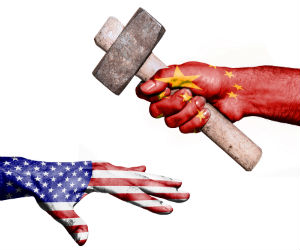A lot has happened in the eight years since a&s’ 100th issue in April 2007. Now, as we celebrate our 200th issue, we take a look at what has had the biggest impact on the industry since 2007 to give us the industry we have today.
While technology has undoubtedly advanced over the years, actual new, innovative technologies within the security industry have been lacking; this has been observed by security players at trade shows around the world. It is true that resolution has gotten better, compression has gotten smaller, and storage has gotten bigger, but these advances are the result of basic technology laws that note the inevitability of technological progress. Therefore, the real change over the last eight years has been changes in the market.
 1. China Market to Take the Top Spot
1. China Market to Take the Top Spot
Currently, the U.S. is still the top market for security demand; however, Memoori Business Intelligence noted Asian markets, particularly China, are taking market share from North America and the EU. In fact, Memoori predicts that China will be the largest single market by the end of 2020.
The Chinese market is still overwhelmingly analog, but the transition to IP is likely to gain momentum soon. According to Memoori, the Chinese government has invested in a massive program to research the IoT, which will help push IP in the country and open up opportunities for overseas companies, as Chinese IP technology is not quite as mature as it is overseas. There are caveats to this: Conducting business in China is very different than it is in other parts of the world. In order to succeed in this market, overseas companies will have to maneuver their way through local market quirks, which from past experience has not always been easy for multinationals trying to penetrate the Chinese market.
Memoori predicts that China will be the largest single market by the end of 2020.
2. Cities Become Safer and Smarter
In 2011, research firm Frost and Sullivan gave a presentation on growth opportunities for security in safe cities in which they talked about how the migration to IP surveillance was crucial to its implementation, since safe cities center around the integration of various systems throughout a city. But, the slower than expected mass adoption of IP surveillance, as well as the global recession, has limited growth. Now that IP surveillance has become standard and the global economy is recovering, more and more governments are implementing safe city initiatives, giving the security industry plenty of opportunities to capitalize on these large-scale projects.
The importance of safe city projects can be seen in the number of major manufacturers that are now offering safe city solutions. Furthermore,
safe cities have been a focus topic for world market, with countries like Mexico, Singapore, China, India, and the EU all rolling out safe/smart city projects.
3. Security's Newest Trifecta: Canon With Milestone and Axis
As in any industry, consolidation is bound to happen. M&As in the security industry are common as the industry has always been highly fragmented.
While there have been many significant M&As since April 2007 (See our security timeline for a more complete picture.), easily one of the most impactful was Canon's acquisition of
Milestone Systems in June 2014 and
Axis Communications in February this year. The
Canon acquisition of Milestone came as quite the surprise, mostly since up to that point Canon did not have a strong foothold in the security arena. Canon further stunned the industry when they announced their
acquisition of Axis. The acquisition of one of the top 2 video management companies and grandfather of IP video showed security players that Canon is targeting security with guns blazing.
 4. No Stopping Chinese Manufacturers
4. No Stopping Chinese Manufacturers
In 2007, Security 50 introduced a new Chinese manufacturer into its ranks:
Hikvision Digital Technology, debuting at number 21. The following year another Chinese manufacturer made its Security 50 debut at number 32:
Dahua Technology.
The impact that Dahua and Hikvision have had on the current video surveillance industry is indisputable. In only a few short years, Hikvision broke into the top 10 and by 2011 placed number 5, breaking into the top 3 last year at number 3. According to IHS, Hikvision ranks number 1 in market share in the global surveillance equipment market, holding an astounding 16.3 percent.
According to IHS, Hikvision ranks number 1 in market share in the global surveillance equipment market, holding an astounding 16.3 percent.
Dahua has also made a rapid climb to the top of the Security 50 rankings, breaking into the top 10 by 2010 and is expected to break into the top 5 this year. Dahua came in at number 2, in terms of global surveillance equipment market share, according to IHS, with an estimated 5.6 percent in 2014.
5. Other Asian Manufacturers Get Knocked Down, but Will Get Up Again
Asian manufacturers have been hit the hardest when it comes to how Dahua and Hikvision have impacted the market — those from Korea and Taiwan have especially been affected by these growing pains.
It is no secret that Korean companies have had a difficult time adapting to the IP shift of video surveillance. Strong in analog, Korean companies such as
CNB Technology have seen declining sales growth caused by both the move to IP and competition brought on by Chinese manufacturers. At its height, CNB ranked in the Security 50 top 20 in both 2011 and 2012; however, as global IP adoption has grown exponentially in the last two years, the company fell to number 38 in 2014 with negative 32.1 percent sales growth from 2013.
Taiwanese companies have also been hit hard by price competition and technology changes. The effects of IP are especially noticeable when looking at
EverFocus Electronics and
VIVOTEK. Since its inception, VIVOTEK has focused on network cameras, and as IP adoption has grown so has their revenue. In fact, the company has steadily risen in the ranks of Security 50, from 49 in 2007 to 19 in 2014. In contrast, EverFocus, who through 2011 always ranked higher than VIVOTEK, has continued to slip in the rankings, coming in at 34 in 2014; but has still done reasonably well compared to many other Taiwanese companies.
6. SMBs Come Up With Consumer and DIY Products
For a long time the security market ignored the small- and mid-sized business (SMB) market, opting instead to target larger, professional markets like government or enterprise. However, as competition within the industry grew fiercer, companies began looking for new markets to target — enter SMBs.
FLIR and Infinova have been the two largest suppliers of consumer and DIY video surveillance in the last few years.
The popularity of consumer and DIY surveillance products as of late has also driven more companies to focus on the SMB market. SMBs often do not have an IT department, IT know-how, or budget to install fancy security systems. Therefore, plug-and-play, easy-to-use consumer- and DIY-type products suit SMB needs. Acknowledging this trend, companies like
FLIR Systems, who acquired Lorex Technology in 2012, and
Infinova, who acquired Swann Communications in 2014, made strategic acquisitions to tap into this market, which has paid off;
according to IHS FLIR and Infinova have been the two largest suppliers of consumer and DIY video surveillance in the last few years.
The Next 8 Years
It is difficult to predict what will happen in the future, but based on the last eight years, it seems like anything can happen. While M&As will definitely continue to consolidate the industry, we hope that this can spark some much needed innovation. Also, as IP in video surveillance has reached maturity, we will see adoption by the access control market increase at a faster rate than it did in video. As for Chinese companies and their effect on the future market, their aggressive marketing tactics and rapid expansion to all regions of the world will continue to challenge other players.